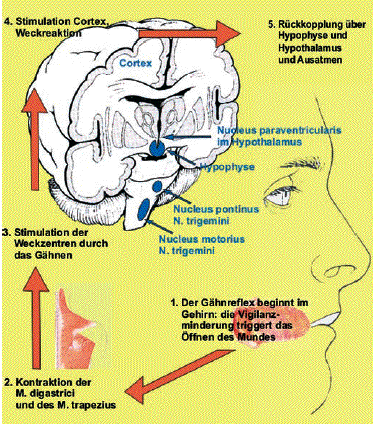- Zusammenfassung
-
- Gähnen ist ein normales physiologisches
Ereignis, das in drei unterschiedliche Phasen
eingeteilt werden kann: eine lange
inspiratorische Phase, einen kurzen
Höhepunkt und eine schnelle
Ausatemphase.
-
- Der Grund für das Gähnen ist noch
nicht klar definiert. Gähnen ist ein
halb-freiwilliger Vorgang, der die
Aufmerksamkeit erhöht und darauf abzielt,
eine Weckreaktion hervorzurufen, wenn
Schläfrigkeit auftritt. Eventuell spielt
das Gähnen zusätzlich eine wichtige
Rolle bei der sozialen Kommunikation. Die
Neuropharmakologie des Gähnens ist sehr
komplex und die Mechanismen sind noch wenig
verstanden.
-
- Das Gähnen steht unter Kontrolle von
verschiedenen Neurotransmittern, deren
wichtigster Dopamin ist. Eine Modellvorstellung
wäre, dass Dopamin die Oxytocin-Produktion
im Nucleus paraventricularis des Hypothalamus
aktivieren könnte und Oxytocin dann
cholinerge Neurotransmission im Hippocampus
auslöst. Acetylcholin könnte dann das
Gähnen über muskarinerge Rezeptoren in
den Effektororganen auslöst. Diese
Modellvorstellung ist jedoch stark vereinfacht.
Viele andere Moleküle können das
Gähnen modulieren, wie z. B. NO, Glutamat,
GABA, Serotonin, ACTH, MSH, Sexual hormone und
Opioide.
-
 -
- Yawning is a physiological event that can be
divided into three distinct phases: a long
inspiratory phase, a brief acme and a rapid
exspiration. The reason for yawning is not yet
well defined. However this semi-voluntary event
increases vigilance and aims to alert when
drowsiness occurs. Yawning may have an important
role for social communication. The
neuropharmacology of yawning is complex and
knowledge of its mechanisms is incomplete. While
under the control of several neurotransmitters,
yawning is largely affected by dopamine.
Dopamine may activate oxytocin production in the
paraventricular nucleus of the hypothalamus,
oxytocin may then activate cholinergic
neurotransmission in the hippocampus, and
finally acetylcholine might induce yawning via
the muscarinic receptors of the effectors. In
fact, this scheme is simplified. Many other
molecules can modulate yawning, such as nitric
oxide, glutamate, GABA, serotonin, ACTH, MSH,
sexual hormones and opium derivate
peptides.
-
- Tous
les articles en allemand sur le
bâillement
|


